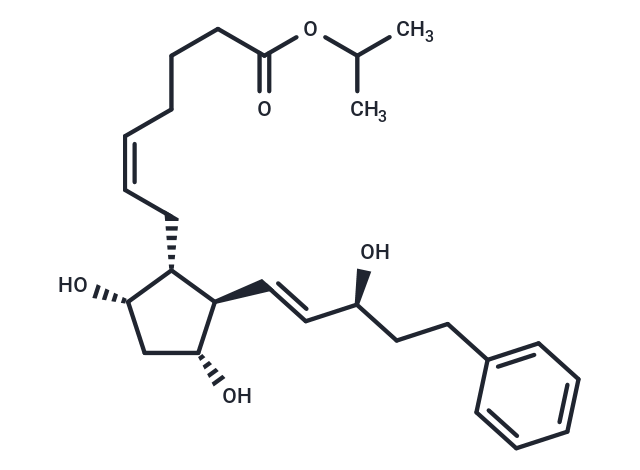- Remove All
 Your shopping cart is currently empty
Your shopping cart is currently empty
17-phenyl trinor Prostaglandin F2α isopropyl ester
17-phenyl trinor PGF2α N-ethyl amide is an F-series prostaglandin analog approved as an ocular hypotensive drug, sold under the Allergan trade name Bimatoprost. The N-ethyl amide prostaglandin prodrugs are converted into the active free acid more slowly than analogous prostaglandin ester prodrugs like latanoprost. This product is the isopropyl ester of the free acid prostaglandin corresponding to Bimatoprost. The free acid, 17-phenyl trinor PGF2α, is a potent FP receptor agonist, and in human and animal glaucoma models, FP receptor agonist activity closely correlates with intraocular hypotensive activity. The 17-phenyl trinor PGF2α isopropyl ester derivative was examined for IOP-lowering activity during latanoprost's development and, at a dose of 3 μg/eye in monkeys, was the most potent analog, reducing IOP by 1.3 mm Hg more than latanoprost, though it was also significantly more irritating to the eye.

17-phenyl trinor Prostaglandin F2α isopropyl ester
| Pack Size | Price | Availability | Quantity |
|---|---|---|---|
| 1 mg | TBD | 35 days | |
| 5 mg | TBD | 35 days | |
| 10 mg | TBD | 35 days |
Product Introduction
| Description | 17-phenyl trinor PGF2α N-ethyl amide is an F-series prostaglandin analog approved as an ocular hypotensive drug, sold under the Allergan trade name Bimatoprost. The N-ethyl amide prostaglandin prodrugs are converted into the active free acid more slowly than analogous prostaglandin ester prodrugs like latanoprost. This product is the isopropyl ester of the free acid prostaglandin corresponding to Bimatoprost. The free acid, 17-phenyl trinor PGF2α, is a potent FP receptor agonist, and in human and animal glaucoma models, FP receptor agonist activity closely correlates with intraocular hypotensive activity. The 17-phenyl trinor PGF2α isopropyl ester derivative was examined for IOP-lowering activity during latanoprost's development and, at a dose of 3 μg/eye in monkeys, was the most potent analog, reducing IOP by 1.3 mm Hg more than latanoprost, though it was also significantly more irritating to the eye. |
| Alias | 17-phenyl trinor Prostaglandin F2α isopropyl ester |
| Molecular Weight | 430.58 |
| Formula | C26H38O5 |
| Cas No. | 130209-76-6 |
| Relative Density. | 1.141 g/cm3 |
| Storage | Powder: -20°C for 3 years | In solvent: -80°C for 1 year | Shipping with blue ice. | |||||||||||||||||||||||||
| Solubility Information | DMF: 30 mg/mL (69.67 mM), Sonication is recommended. DMSO: 30 mg/mL (69.67 mM), Sonication is recommended. Ethanol: 50 mg/mL (116.12 mM), Sonication is recommended. Ethanol:PBS (pH 7.2) (1:1): 1 mg/mL (2.32 mM), Sonication is recommended. | |||||||||||||||||||||||||
Solution Preparation Table | ||||||||||||||||||||||||||
DMF/DMSO/Ethanol
| ||||||||||||||||||||||||||
Sci Citations
Calculator
In Vivo Formulation Calculator (Clear solution)
Dose Conversion
Tech Support
Keywords

Copyright © 2015-2025 TargetMol Chemicals Inc. All Rights Reserved.




